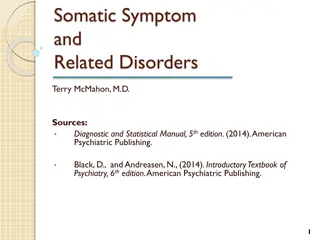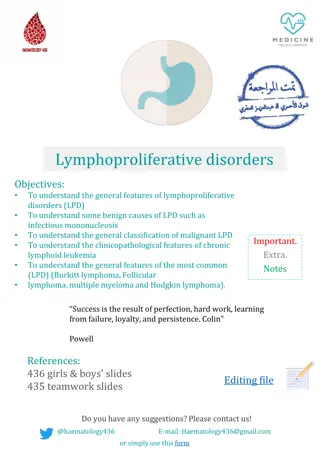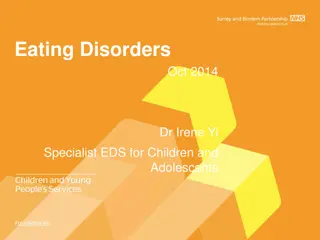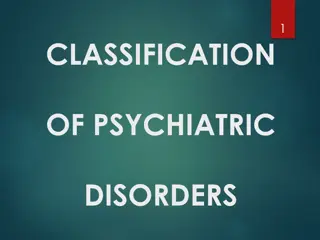Understanding Lymphoproliferative Disorders: A Comprehensive Overview
Lymphoproliferative disorders encompass various clinical conditions involving the excessive production of lymphocytes, such as lymphoma and lymphoid leukemia. This article delves into the definitions, causes, and specific types of lymphoproliferative disorders, including infectious mononucleosis and malignant lymphoproliferative diseases. Detailed explanations of lymphocytosis and different lymphomas are also provided, shedding light on these conditions for a better understanding.
- Lymphoproliferative Disorders
- Lymphoma
- Leukemia
- Infectious Mononucleosis
- Malignant Lymphoproliferative
Download Presentation

Please find below an Image/Link to download the presentation.
The content on the website is provided AS IS for your information and personal use only. It may not be sold, licensed, or shared on other websites without obtaining consent from the author. Download presentation by click this link. If you encounter any issues during the download, it is possible that the publisher has removed the file from their server.
E N D
Presentation Transcript
LYMPHOPROLIFERATIVE DISORDERS BY: DR. FATMA AL-QAHTANI CONSULTANT HAEMATOLOGIST HEAD OF HAEMATOLOGY DIVISION DEPARTMENT OF PATHOLOGY
Definition Lymphoproliferative disorders Several clinical conditions in which lymphocytes are produced in excessive quantities ( Lymphocytosis) Lymphoma Malignant lymphoid mass involving the lymphoid tissues ( other tissues e.g : skin ,GIT ,CNS ) Lymphoid leukemia Malignant proliferation of lymphoid cells in Bone marrow and peripheral blood ( other tissues e.g : lymph nods ,spleen , skin ,GIT ,CNS )
Lymphoproliferative disorders Infection Autoimmune Malignant
Lymphocytosis 1- Viral infection : Infectious mononucleosis ,cytomegalovirus ,rubella, hepatitis, adenoviruses, varicella . 2- Some bacterial infection: (Pertussis ,brucellosis ) 3-Immune : SLE , Allergic drug reactions 4- Other conditions:, splenectomy, dermatitis ,hyperthyroidism metastatic carcinoma .) 5- Chronic lymphocytic leukemia (CLL) 6-Other lymphomas: Mantle cell lymphoma ,Hodgkin lymphoma
Infectious mononucleosis An acute, infectious disease, caused by Epstein-Barr virus and characterized by fever swollen lymph nodes (painful) Sore throat, atypical lymphocyte Affect young people ( usually) http://3.bp.blogspot.com/_jRgGstwXxTo/R-s0hEFd6EI/AAAAAAAAFEA/CCIHiBbJTYw/s400/HEME013.jpg http://bioweb.uwlax.edu/bio203/s2009/weisser_mich/tonsils.JPG http://upload.wikimedia.org/wikipedia/commons/c/cf/Lymphadanopathy.JPG
Malignant Lymphoproliferative Disorders
ALL CLL Lymphomas germinalcenter MM na ve B-lymphocytes Plasma cells Lymphoid progenitor T-lymphocytes AML Myeloproliferative disorders Hematopoietic stem cell Myeloid progenitor Neutrophils Eosinophils Basophils Monocytes Platelets Red cells
Malignant Lymphoproliferative disorders Immature Mature ALL Lymphoid leukemia Lymphoma CLL Hairy cell leukemia T- prolymphocytic leukemia Leukemic phase of lymphoma Non Hodgkin lymphoma Hodgkin lymphoma B- cell neoplasm T- cell neoplasm 90% 10% Burkitt lymphoma Diffuse large B lymphoma Follicular lymphoma Multiple myeloma Adult T leukemia lymphoma Sezary syndrome Large anaplastic T lymphoma
CD34 &TDT Surface immunoglobin CD 19 CD20 CD 5 CD10 Mantle zone stem cell Germinal center CD5,CD23 IgM or IgD lymphoid progenitor Mature na ve B-cell progenitor-B GC blast Centroblast pre-B Centrocyte plasma cell CD38 ,CD138 IgG or IgA ,IgE
CD34 &TDT Surface immunoglobin CD 19 CD20 CD10 CD 5 Burkitt lymphoma DLBCL t(3;14) BCL-6 t(8;14) C-myc CD5 ,CD23 ,IgM or IgD CLL t(11;14) Cyklin D t(14;18) BCL-2 Mantle lymphoma Multiple myeloma Follicular lymphoma ALL CD38 ,CD138, CD56 IgG or IgA or IgE
Chronic Lymphocytic Leukemia Malignant neoplasim characterized by an increased number of small, mature lymphocytes in the blood (>5,000 ) and bone marrow ( spleen and lymph node) The most common adult leukemia (~25% of adult leukemias) The median age is ~55 to 65 years. ( rare < 40 years). 1.5 to 2 times more common in men than women.
Features of CLL 40% of patients are asymptomatic at diagnosis. Moderate lymphadenopathy and splenomegaly Lymphocytosis (>5,000): Small mature-appearing lymphocytes Condensed ( soccer ball ) nuclear chromatin Numerous smudge cells Predisposition to infection Autoimmune phenomena (autoimmune hemolytic anemia) Transformation to large cell lymphoma (Richter s syndrome) http://www.pathpedia.com/education/eatlas/histopathology/blood_cells/chronic_lymphocytic_leukemia_(cll)_b-cell/chronic-lymphocytic-leukemia-%5b3-bl021-3%5d.jpeg?Width=600Height=450Format=4
CLL Staging Rai Staging Prognosis Watch &wait chemo FCR
Burkitt's lymphoma High-grade non-Hodgkin's B-cell lymphoma which is rapidly growing and highly aggressive with extremely short doubling time (24 hrs) Types of Burkitt's lymphoma 1-Endemic: associated with chronic malaria and EBV In equatorial Africa . It particularly affects the jaw, other facial bone and breast. Sporadic: occurs throughout the world and affects GIT. Immunodeficiency-associated: associated with HIV infection or the use of immunosuppressive drugs
Morphology BMA Biobsy Burkitt lymphoma, touch prep, Wright stain.jpg http://www.pathpedia.com/education/eatlas/histopathology/lymph_node/burkitt_lymphoma/burkitt-lymphoma-%5b1-ln071-1%5d.jpeg?Width=600Height=450Format=4 Homogenous medium size cells with round nuclei and deeply basophilic and vacuolated cytoplasm Diffuse infiltration with "starry sky (Macrophages engulfing the apoptotic cells)
Genetics of BL Highly associated with t(8;14): Translocation of the c-MYC proto-oncogene at chromosome 8 to immunoglobulin gene at chromosome 14 The c-MYC is nuclear transcription factor . Burkitt s lymphoma is the fastest growing tumor in humans.
Clinical Presentation After 25 D of intensive chemotherapy Cure rate: 90% at early phase 70% at advance disease
Follicular lymphoma FL is malignant proliferation of germinal center B cells centrocyte which has at least a partially follicular pattern. Due to overexpression o f Bcl2 caused by t(14;18) . Most common type of indolent lymphoma (25% ). Presented as: Lymphadenopathy (100%) splenomegaly (80%) BM involvement (60%) blood involvement (40%). Indolent but incurable (some exceptions)
Diagnosis CD10 http://www.pathpedia.com/education/eatlas/histopathology/lymph_node/follicular_lymphoma/image_name_%E2%80%93_follicular-lymphoma-%5b3-ln013-1%5d-3.jpeg?Width=600Height=450Format=4 BCL2 Immunophenotyping: Positive for CD10,CD20 and Bcl2 Negative for CD5 ( in most cases) CD5
Management Median survival is around 10 years. Transformation to aggressive lymphoma (DLBCL) can occur. http://hematologyoutlines.com/images/Follicular-lymphoma-high-power.jpg http://www.pathpedia.com/education/eatlas/histopathology/lymph_node/follicular_lymphoma/image_name_%E2%80%93_follicular-lymphoma-%5b8-ln069.jpeg?Width=600Height=450Format=4 http://www.pathpedia.com/education/eatlas/histopathology/lymph_node/follicular_lymphoma/follicular-lymphoma-%5b9-ln060-1%5d-9.jpeg?Width=600Height=450Format=4 Aggressive Low grade FL FL in transformation transformation (DLBCL) Watch and weight (most often) Aggressive Chemotherapy Chemotherapy( SCT)
Multiple Myeloma Malignant B neoplasm characterized by a triad of abnormalities: Accumulation of plasma cells in the bone marrow Lytic Bone lesions Production of a monoclonal immunoglobulin (Ig) or Ig fragments
Pathogenesis of MM For reading For reading
Hodgkin lymphoma Thomas Hodgkin (1798-1866)
Classical Hodgkin Lymphoma Indolent malignant lymphoma characterized by : 1- presence of few large binucleated cells (Reed-Sternberg ) surrounded by reactive cells (lymphocytes, plasma cells ,eosinophils) 2- Involving cervical lymph nodes in young adults (most often ) http://www.jpgathology.com/slides-13/slides/LymphNode_HodgkinsLymphoma_NS_ReedSternberg2.jpg
A possible model of pathogenesis loss of apoptosis transforming event(s) EBV? cytokines germinal centre B cell RS cell inflammatory response
Diagnosis of Hodgkin Lymphoma CD 15 CD 30 https://static.fishersci.com/images/F110468~wl.jpg http://www.bloodjournal.org/content/bloodjournal/96/9/3133/F1.large.jpg
For reading For reading























